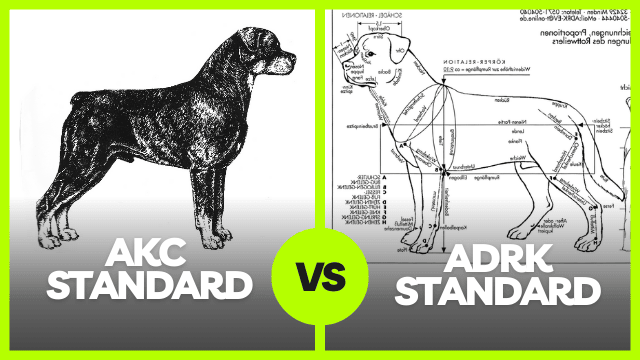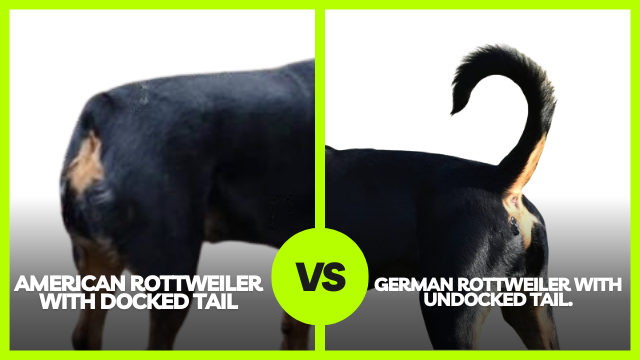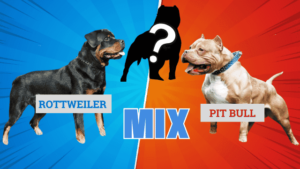-
Flavors: "American" and "German" Rottweilers aren't separate breeds, just variations within the same amazing breed. Think different toppings on the same delicious pizza!
-
History Buffs Unite: Rottweilers have a rich history, tracing back to Roman times. They've been herders, protectors, and loyal companions throughout the ages.
-
Standards Schmandards: The AKC and ADRK have slightly different standards for what makes an "ideal" Rottweiler, leading to subtle variations in appearance.
-
Personality Plus: Rottweilers are known for their loyalty, intelligence, and protective instincts. Early socialization and training are key to raising a well-adjusted Rottie.
-
Health is Wealth: Responsible breeding practices and preventative care are crucial for ensuring a long and happy life for your Rottweiler.
Hey there, fellow Rottweiler enthusiasts! Ever heard someone say “German Rottweiler” and wondered if it was some exotic, super-rare breed? Well, get ready to have your mind blown because we’re about to bust that myth wide open! “American Rottweiler” and “German Rottweiler” are often thrown around like they’re totally different dogs, but here’s the truth: they’re both just awesome Rottweilers!
We’re going to dive into this friendly showdown, explore those subtle variations, and celebrate everything that makes this breed so amazing.
From Roman Roads to Modern Homes: The Rottweiler's Epic Journey

To understand the subtle differences between ‘American’ and ‘German’ Rottweilers, let’s first delve into their shared history. As the American Kennel Club notes, Rottweilers have a fascinating lineage that dates back to the Roman Empire. Way back in the day, Rottweilers were the ultimate sidekicks for Roman soldiers, herding their cattle and guarding their camps. Talk about an adventurous life!
Fast forward a few centuries, and these tough pups found themselves in Rottweil, Germany, where they became the go-to helpers for butchers. They herded livestock, pulled carts loaded with meat, and basically proved they were the ultimate multitaskers.
But here’s the thing: Rottweilers are more than just brawn. They’re intelligent, loyal, and incredibly adaptable. That’s why they’ve rocked so many roles throughout history, from police dogs to service dogs to the best cuddle buddies you could ask for. Knowing this history helps us understand why there are some differences between those “American” and “German” labels today.
AKC vs ADRK: The Rottweiler Rulebook Showdown!
Alright, time to get a bit official! The Fédération Cynologique Internationale (FCI) provides a detailed breed standard that highlights the desired physical and temperamental traits of a Rottweiler. This standard, which emphasizes a balanced physique and specific proportions, has heavily influenced German breeding practices. Two big players set the standards for what makes a Rottweiler a Rottweiler: the American Kennel Club (AKC) in the U.S. and the Allgemeiner Deutscher Rottweiler Klub (ADRK) in Germany. Think of them like the rulebooks for this awesome breed.
- AKC: These guys love a compact, powerful build with a docked tail. They’re a bit more relaxed about specific angles and proportions.
- ADRK: They’re all about those strict standards, with a focus on a balanced physique, specific proportions, and a natural tail.
Basically, the AKC and ADRK have slightly different ideas about the “ideal” Rottweiler. It’s like comparing a classic New York-style pizza to a deep-dish Chicago pizza – both delicious, but with their own unique flair!
American Rottweiler vs German Rottweiler – Think You Can Tell 'Em Apart?
Alright, Rottweiler fans, time to put on your detective hats! We’re diving into the subtle art of Rottweiler spotting. Both “American” and “German” Rotties rock that iconic black and tan coat, but with a keen eye, you might just be able to tell them apart. Think you’ve got what it takes?

Size Matters (Sometimes!):
Picture this: a German Rottweiler strolls by, looking like the linebacker of the dog world – big, strong, and built to tackle anything. Now, imagine an American Rottweiler, leaner and more agile, like the star quarterback weaving through defenders. See the difference? German Rottweilers often have a bit more bulk, while American Rottweilers tend to be a tad more streamlined.
Built for Action (in Slightly Different Ways):
Speaking of builds, let’s talk physique! German Rottweilers are often bred with a focus on power and substance, giving them that classic, robust look. American Rottweilers, on the other hand, sometimes lean towards a more athletic build, with a bit more emphasis on agility and speed. Think of it like comparing a powerful truck to a sleek sports car – both awesome in their own way!
Head Games:

Now, let’s get up close and personal with those handsome Rottweiler heads. German Rottweilers often have a broader head with a more pronounced “stop” – that’s the indentation between the eyes. It’s like their forehead says, “I’m serious and I mean business!” American Rottweilers might have a slightly less pronounced stop, giving them a slightly softer expression.
The Tale of the Tail:

Here’s the biggest tell-tale sign (pun intended!): the tail! In the U.S., it’s common for Rottweilers to have docked tails, giving them that distinctive look. But in Germany, tail docking is often frowned upon, so German Rottweilers usually keep their natural tails wagging proudly. It’s a quick and easy way to spot the difference from afar!
-
Remember: These are just general tendencies, folks! Every Rottweiler is an individual, and you'll find plenty of variations within both "types." It's like saying all humans with brown hair are the same – definitely not the case! So, while these tips can be helpful, don't judge a Rottie by its appearance alone. Get to know their unique personality, and you'll discover what truly makes them special.
More Than Muscles: Unleashing the Rottweiler's Amazing Personality
Rottweilers are way more than just a handsome face and a powerful physique. These dogs have hearts of gold and personalities that shine! They’re loyal, protective, and smart as a whip. They love being around their humans and need plenty of mental stimulation to keep those brains busy.
While both American and German Rottweilers share these awesome traits, there might be some subtle differences in their personalities:
- Confidence: German Rottweilers, bred for working roles, might be a bit more assertive and confident. They’re like, “I got this!”
- Reservedness: American Rottweilers, often bred for companionship, might be a tad more reserved around new people. They’re like, “I’ll warm up to you eventually, but let’s take it slow.”
No matter where your Rottweiler hails from, early socialization and consistent training are key to raising a well-adjusted pup.
Training a Rottweiler Rockstar: From Puppy Padawan to Canine Jedi Master
Rottweilers are eager to please and super intelligent, which makes them a dream to train (most of the time!). But remember, they’re also powerful dogs with protective instincts, so you need to be a firm and consistent leader.
Here’s the Rottweilerpaw.com guide to training success:
- Start Early: The sooner you start training and socialization, the better. Think of it like shaping a young Padawan into a Jedi Master.
- Positive Vibes Only: Ditch the harsh punishments and embrace positive reinforcement. Treats, praise, and a happy voice go a long way!
- Consistency is Key: Set clear rules and stick to them. Your Rottweiler needs to know what’s expected of them.
- Social Butterfly: Expose your Rottie to all sorts of people, places, and situations. This helps them build confidence and prevents them from becoming fearful or reactive.
- Tackle Challenges Head-On: Be ready to address potential issues like separation anxiety or reactivity towards other dogs. A little proactive training can prevent big headaches down the road.
With the right approach, you can help your Rottweiler become a well-mannered superstar who shines in any situation. We’ve covered some training basics, but if you’re ready to become a true Rottweiler training expert, you need this comprehensive guide: Rottweiler Training: The Complete Guide [Expert Tips & Techniques]
Rottweiler Health and Care: Your Guide to a Superpowered Pup
While Rottweilers are generally healthy dogs, it’s essential to be aware of potential health issues that can affect this breed. PetMD provides a helpful overview of common Rottweiler health problems, including hip dysplasia and aortic stenosis:
- Hip and Elbow Dysplasia: This is a common issue in large breeds, affecting their joints. Think of it like arthritis in dogs.
- Aortic Stenosis: A heart condition that can make it harder for blood to flow.
- Osteosarcoma: A type of bone cancer.
Here’s how to keep your Rottweiler feeling super:
- Vet Visits are a Must: Regular checkups and vaccinations are crucial. Think of it like routine maintenance for your furry superhero.
- Fuel Up with Good Food: Feed your Rottie a high-quality diet that’s made for large breed dogs.
- Exercise is Key: Make sure your Rottweiler gets plenty of exercise to stay fit and avoid joint problems.
- Brain Games: Keep their minds engaged with interactive toys and puzzles. A bored Rottweiler can get into mischief!
We’ve touched on some common health concerns, but there’s a whole lot more to learn about keeping your Rottweiler in top shape. For a deep dive into Rottweiler health, including common issues, preventative care, and tips for a long and happy life, check out our comprehensive guide: Rottweiler Health 101: A Guide to Common Issues & Preventative Care.
You’ll discover everything you need to know to be the best possible health advocate for your furry friend.
American vs German Rottweiler: Which One's Your Perfect Sidekick?
So, you’ve fallen head over paws for Rottweilers and you’re ready to welcome one into your life? That’s awesome! But hold on a sec – with those subtle differences between “American” and “German” Rottweilers, how do you know which one’s your perfect match? Don’t worry, we’ve got you covered!
Let’s play a little game of “Rottweiler Matchmaker”:
- Lifestyle: Are you a go-getter who loves hiking, running, and adventures? Or are you more of a homebody who enjoys cozy nights and Netflix marathons? A high-energy German Rottweiler might be the perfect adventure buddy, while a slightly more laid-back American Rottweiler might be the ideal cuddle companion.
- Experience: Are you a seasoned dog owner who’s mastered the art of puppy training? Or are you a newbie who’s just starting your dog-parent journey? If you’re new to the dog world, an American Rottweiler’s sometimes slightly more mellow temperament might be a good fit. If you’re a pro, you might be ready for the challenge of a German Rottweiler’s assertive personality.
- Family Matters: Got a house full of kids and other furry friends? Rottweilers can be amazing family dogs, but it’s important to choose a pup with a temperament that matches your crew. Consider a breeder who focuses on socializing their puppies with kids and other animals.
- Home Sweet Home: Do you have a sprawling backyard where your Rottweiler can romp and play? Or are you living the apartment life? While Rottweilers can adapt to apartment living with proper exercise, a spacious yard might be a better fit for a high-energy German Rottweiler.
The Golden Rule of Rottweiler Hunting:
No matter which type of Rottweiler you’re leaning towards, remember this golden rule: prioritize temperament and health over looks! A responsible breeder will focus on producing well-adjusted, healthy pups, not just ones that fit a certain “look.” Don’t be afraid to ask questions, visit the breeder’s facility, and meet the parents of your potential pup. It’s all about finding a Rottweiler who will thrive in your home and become your lifelong companion.
Finding the right Rottweiler is like finding a soulmate – it’s all about that special connection! So, trust your gut, do your research, and get ready to welcome an amazing dog into your life.
- Lifestyle: Are you a go-getter who loves hiking, running, and adventures? Or are you more of a homebody who enjoys cozy nights and Netflix marathons? A high-energy German Rottweiler might be the perfect adventure buddy, while a slightly more laid-back American Rottweiler might be the ideal cuddle companion.
Beyond Labels: What Really Makes a Rottweiler
Okay, so we’ve talked about “American” and “German” Rottweilers, but here’s the thing: those labels only tell part of the story. Just like humans, every Rottweiler is an individual with their own unique personality, quirks, and talents. It’s like judging a book by its cover – you might miss out on an amazing story!
So, let’s go beyond those labels and explore what really makes a Rottweiler tick:
Strut Your Stuff: The Rottweiler Runway
Ever watched a Rottweiler move? It’s like poetry in motion! But did you know there can be subtle differences in their gait? German Rottweilers, with their history of herding and pulling carts, often have a powerful, ground-covering stride. It’s like they’re saying, “I’m here to get things done!” American Rottweilers, on the other hand, might have a bit more spring in their step, like they’re always ready for a game of fetch.
Born to Work (or Play!): The Rottweiler Skillset
Rottweilers were bred to be working dogs, and that instinct is still strong in many of them. German Rottweilers, especially those from working lines, might have a stronger drive for tasks like herding, guarding, or even competing in dog sports. They’re like, “Give me a job, and I’ll rock it!” But even American Rottweilers, often bred more for companionship, can excel at these activities with the right training and motivation. It’s all about tapping into their natural talents!
Rules are Rules: Breeding Regulations
Before you bring a Rottweiler home, it’s important to know the rules in your area. Some places have regulations about things like tail docking or breeding practices. So, do your homework and make sure you’re working with a responsible breeder who follows the guidelines.
The Heart Wants What it Wants: Finding Your Perfect Rottweiler
At the end of the day, the best Rottweiler for you is the one that captures your heart. It’s about that special connection, that spark that says, “This is my dog!” So, don’t get too hung up on labels or appearances. Focus on finding a Rottweiler with a temperament that matches yours and a personality that makes you smile. That’s what truly matters!
Whether you choose an “American” or “German” Rottweiler, or a mix of both, you’re in for an amazing adventure. These dogs are loyal, loving, and full of life. So, open your heart and get ready to welcome a furry friend who will change your life for the better!
Final Thought: The Rottweiler - A Breed Worth Celebrating
Whether you’re Team American or Team German (or maybe just Team Awesome Rottweiler!), one thing’s for sure: these dogs are truly something special. They’re loyal protectors, playful companions, and intelligent partners, ready to take on any adventure with their humans by their side.
So, let’s celebrate the Rottweiler in all its forms, embracing the unique variations and cherishing the qualities that make this breed so amazing. And remember, no matter where your Rottweiler comes from, the most important thing is to give them the love, care, and training they deserve to thrive.
Here’s to those slobbery smiles, those wagging tails, and those unforgettable moments that make Rottweiler ownership such a rewarding experience!
FAQs
1. Are American Rottweilers more aggressive than German Rottweilers?
Nope! Aggression isn't determined by where a Rottweiler is born. Both "types" can be equally loving and protective. Temperament depends more on individual personality, upbringing, and training.
2. Do Rottweilers need a lot of exercise?
Absolutely! Rottweilers are energetic dogs who need plenty of physical and mental stimulation. Daily walks, playtime, and interactive games are a must.
3. Are Rottweilers good with kids?
With proper socialization and training, Rottweilers can be fantastic family dogs. However, it's crucial to supervise interactions between children and dogs, teach kids how to interact respectfully, and choose a Rottweiler with a temperament that suits your family dynamic.
4. Are Rottweilers easy to train?
Rottweilers are intelligent and eager to please, which makes them highly trainable. However, they also have a strong will and protective instincts, so consistent, positive reinforcement training is essential.
5. Where can I find a reputable Rottweiler breeder?
Start by researching breeders in your area and checking their credentials. Look for breeders who prioritize health testing, temperament evaluation, and ethical practices. Don't hesitate to ask questions and visit their facility to see the conditions firsthand. You can also check with Rottweiler breed clubs or rescue organizations for recommendations.
We’ve just scratched the surface of what makes these dogs so incredible. If you’re ready to dive deeper into the world of Rottweilers, check out our epic guide: Amazing Rottweiler Breed Facts: History, Temperament & Care.
You’ll discover fascinating facts about their history, unravel the mysteries of their temperament, and learn everything you need to know to provide the best possible care for your Rottie. It’s the ultimate resource for any Rottweiler lover!






